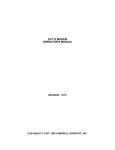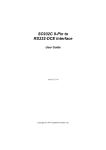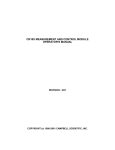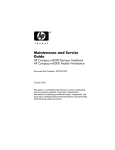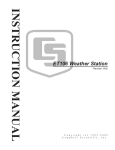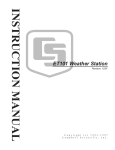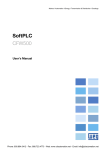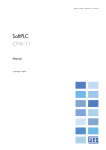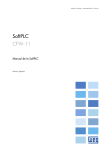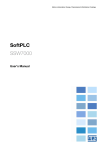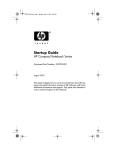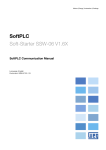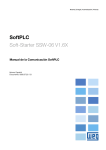Download Campbell NW8002 Instruction manual
Transcript
NW8002 WEATHER STATION INSTALLATION INSTRUCTION MANUAL REVISION: 3/97 COPYRIGHT (c) 1991-1997 CAMPBELL SCIENTIFIC, INC. WARRANTY AND ASSISTANCE The NW8002 WEATHER STATION is warranted by CAMPBELL SCIENTIFIC, INC. to be free from defects in materials and workmanship under normal use and service for twelve (12) months from date of shipment unless specified otherwise. Batteries have no warranty. CAMPBELL SCIENTIFIC, INC.'s obligation under this warranty is limited to repairing or replacing (at CAMPBELL SCIENTIFIC, INC.'s option) defective products. The customer shall assume all costs of removing, reinstalling, and shipping defective products to CAMPBELL SCIENTIFIC, INC. CAMPBELL SCIENTIFIC, INC. will return such products by surface carrier prepaid. This warranty shall not apply to any CAMPBELL SCIENTIFIC, INC. products which have been subjected to modification, misuse, neglect, accidents of nature, or shipping damage. This warranty is in lieu of all other warranties, expressed or implied, including warranties of merchantability or fitness for a particular purpose. CAMPBELL SCIENTIFIC, INC. is not liable for special, indirect, incidental, or consequential damages. Products may not be returned without prior authorization. To obtain a Returned Materials Authorization (RMA), contact CAMPBELL SCIENTIFIC, INC., phone (435) 753-2342. After an applications engineer determines the nature of the problem, an RMA number will be issued. Please write this number clearly on the outside of the shipping container. CAMPBELL SCIENTIFIC's shipping address is: CAMPBELL SCIENTIFIC, INC. RMA#_____ 815 West 1800 North Logan, Utah 84321-1784 CAMPBELL SCIENTIFIC, INC. does not accept collect calls. Non-warranty products returned for repair should be accompanied by a purchase order to cover the repair. 815 W. 1800 N. Logan, UT 84321-1784 USA Phone (435) 753-2342 FAX (435) 750-9540 www.campbellsci.com Campbell Scientific Canada Corp. 11564 -149th Street Edmonton, Alberta T5M 1W7 CANADA Phone (403) 454-2505 FAX (403) 454-2655 Campbell Scientific Ltd. Campbell Park 80 Hathern Road Shepshed, Leics. LE12 9RP ENGLAND Phone (44)-50960-1141 FAX (44)-50960-1091 NW8002 WEATHER STATION INSTALLATION INSTRUCTION MANUAL TABLE OF CONTENTS PAGE Warranty .....................................................................................................................................................i Introduction .............................................................................................................................................. I-1 1. 1.1 1.2 1.3 1.4 1.5 1.6 1.7 1.8 1.9 1.10 2. 2.1 2.2 2.3 2.4 3. 3.1 3.2 3.3 WEATHER STATION DESCRIPTION AND INSTALLATION .................................. 1-1 Standard Sensors................................................................................................................... 1-1 Weather Station Site Selection............................................................................................... 1-1 Equipment .............................................................................................................................. 1-2 Mast Installation Instructions .................................................................................................. 1-6 Power Supply Options ............................................................................................................ 1-9 Sensor Wiring....................................................................................................................... 1-10 Station Grounding................................................................................................................. 1-10 SRM-6A Rad Modem ........................................................................................................... 1-13 Phone Modem Communication ............................................................................................ 1-15 System Check-Out ............................................................................................................... 1-15 MAINTENANCE ...................................................................................................................... 2-1 Weekly.................................................................................................................................... 2-1 Monthly ................................................................................................................................... 2-1 Moisture.................................................................................................................................. 2-2 Maintenance Log Book........................................................................................................... 2-3 TROUBLE SHOOTING ......................................................................................................... 3-1 Communication Testing.......................................................................................................... 3-1 Sensors .................................................................................................................................. 3-3 Datalogger .............................................................................................................................. 3-5 FIGURES 1.2-1 1.3-1 1.3-2 1.3-3 1.4-1 1.4-2 1.4-3 1.4-4 1.5-1 1.6-1 1.6-2 1.7-1 1.8-1 1.8-2 1.9.1 2.1-1 Effect of Structure on Wind Flow............................................................................................ 1-2 NW8002 Enclosure with RAD Connection ............................................................................. 1-3 NW8002AC/SP Weather Station Cross Arm Connection ...................................................... 1-4 NW8002AC Weather Station ................................................................................................. 1-5 MW8002 Cement Base .......................................................................................................... 1-7 NW8002 Tower with Tilt Base ................................................................................................ 1-7 NW8002AC/SP Weather Station (Top View) ......................................................................... 1-8 Plumbing NW8002 Tower ...................................................................................................... 1-8 PS12 Volt Power Supply and Charging Regulator ................................................................. 1-9 NW8002SP Weather Station................................................................................................ 1-11 NW8002 Weather Station Sensor Connection..................................................................... 1-12 NW8002 Station Grounding ................................................................................................. 1-13 RAD Modem Connection and Grounding ............................................................................. 1-14 NW8002 Master Station ....................................................................................................... 1-15 NE8002 Enclosure with DC112 Phone Modem Option ........................................................ 1-16 Rain Gage .............................................................................................................................. 2-1 2.3-1 2.3-2 2.3-3 3.1-1 3.1-2 3.2-1 Solar Sensor........................................................................................................................... 2-2 6575 Temperature/Relative Humidity Probe .......................................................................... 2-2 4831 Temperature/Relative Humidity Probe Assembly.......................................................... 2-3 RAD Testing Computer End ................................................................................................... 3-1 RAD Testing Datalogger End ................................................................................................. 3-2 4831 Temperature/Relative Humidity Probe Assembly.......................................................... 3-5 TABLES 1.2-1 1.5-1 3.3-1 Approximate Range, Miles ..................................................................................................... 1-1 PS12-LA Battery and AC Transformer Specifications.......................................................... 1-10 Sensor Verification; Accessing CR10 Input Locations ........................................................... 3-6 INTRODUCTION This manual covers both the NW8002AC (115 VAC power only) and the NW8002SP (solar panel) weather stations. These weather stations are setup to communicate with the NW8000 central computer over a short haul modem link. The heart of the weather station is the Campbell Scientific, Inc. CR10 Measurement and Control Module. A 2.5 amp hour 12 VDC sealed lead acid battery pack powers the CR10. A solar panel or 115 VAC power is used to trickle charge the batteries. Wind Direction SPECIFICATIONS Power 12 VDC/115 VAC, 60 Hz Avg. current drain .16 A (115 VAC) 6 mA (solar panel) Operating temperature range -25°C to +50°C Operating relative humidity range 0 to 100% non-condensing SENSOR SPECIFICATIONS -35°C to +48°C ±4°C, typically better than ±2°C Relative Humidity Range Accuracy 12 - 97% RH ±5% Wind Speed Range Threshold 0 - 112 mph 1.1 mph 0 - 112 mph 1.8 mph +5° Rain Orifice Accuracy Resolution 6" 1% at 2"/hr or less 0.01 inches Global Radiation Linearity Accuracy Temperature Range Accuracy Range Threshold Accuracy -2 1% up to 3000 Wm ±5% maximum, typically ±3% NOTE: The black outer jacket of the cables ® is Santoprene rubber. This compound was chosen for its resistance to temperature extremes, moisture, and UV degradation. However, this jacket will support combustion in air. It is rated as slow burning when tested according to U.L. 94 H.B. and will pass FMVSS302. Local fire codes may preclude its use inside buildings. I-1 SECTION 1. WEATHER STATION DESCRIPTION AND INSTALLATION The weather station is designed to collect weather data for calculation of evapotranspiration of the surrounding area where it is located. The selection of the weather station site is important; a poor site will give non representative measurements which result in inacurate ET values. 1.1 STANDARD SENSORS Sensors with preassigned channels include: • • • • • • Wind speed Wind direction Temperature Solar radiation Rainfall Relative humidity 1.2 WEATHER STATION SITE SELECTION 1. Trees, buildings, or other structures can greatly influence wind speed and direction observations. As a rule of thumb, a structure will disturb the air flow an upwind distance of about twice the height of the structure, a downwind distance of about six times the height of the structure, and a vertical distance of up to twice the height of the structure (Figure 1.2-1). 2. The station should be located over the most typical type of turf used on the course. It must not be placed over a concrete slab, parking lot, or unplanted earth. This allows the temperature and humidity readings to closely correspond with that of the turf the ET value is to represent. 3. The radiation shield that covers the probe provides protection from direct sunlight and rain. The shield does not protect against irrigation water should any be sprayed up into the plates. NOTE: The weather station should not be located where sprinklers spray water into the rain bucket or onto the radiation shield. 4. The Solar Radiation Sensor should be located so it is not shadowed by surrounding objects. 5. The weather station should not be placed at the top of a knoll or mound, but in an area lower than the surrounding hills if possible. This lowers the probability of it being struck by lightning. 6. During installation, extreme care should be taken to avoid touching or coming near power lines. Contact could be fatal. Do not locate the station in the vicinity of overhead power lines. 7. The distance from the weather station to the central computer determines the gage of the wire and the baud rate used. In Table 1.2-1, wire gage, distance, and baud rate can be determined. TABLE 1.2-1 Approximate Range, Miles Data Rate 19 Gage bps Miles 9,600 1,200 5.0 6.5 24 Gage Miles 4.0 5.0 26 Gage Miles 2.5 3.5 1-1 SECTION 1. WEATHER STATION DESCRIPTION AND INSTALLATION FIGURE 1.2-1 Effect of Structure on Wind Flow 1.3 EQUIPMENT The following lists describe the equipment provided by Campbell Scientific, Inc. and those materials provided by the user. 1.3.1 MATERIALS PROVIDED BY CSI SRM-6A ENC 12/14 101-T RAD Modem Nema 4X Enclosure Nutone 16V 10 VA Transformer Hardware: 6885 10' Tower Crossarm & sensor mounts Tilt base & anchor bolts Gill radiation shield Allen wrench Electrician putty Desiccant 1.3.2 MATERIALS SUPPLIED BY USER Packaged Inside The Enclosure: (Figure 1.3-1) ITEM DESCRIPTION CR10 SRM-6A SC932 DC112 1 2 3 4 Cement All conduit for 16 VAC AC power AC power installation and cable All communication wire from computer to weather station, see Section 1.8 for recommended cables 6 ft. copper ground rod RS232 Serial Port Card for central computer PS12-LA Measurement and Control Module RAD Modem 9 Pin to RS232-DCE Interface Optional phone modem (for use with Mir 5000 systems only, Figure 1.9-1). 12 V Rechargeable Battery Sensors: (Figure 1.3-2) 4776 6575 4830 5537 5538 1-2 Li-Cor Solar Radiation Sensor HMP35C Temperature and RH Probe Texas Electronics Rain Gage R.M. Young Wind Speed R.M. Young Wind Direction 5 6 SECTION 1. WEATHER STATION DESCRIPTION AND INSTALLATION FIGURE 1.3-1. NW8002 Enclosure with RAD Connection 1-3 SECTION 1. WEATHER STATION DESCRIPTION AND INSTALLATION FIGURE 1.3-2. NW8002AC/SP Weather Station Cross Arm Detail 1-4 SECTION 1. WEATHER STATION DESCRIPTION AND INSTALLATION FIGURE 1.3-3. NW8002AC Weather Station 1-5 SECTION 1. WEATHER STATION DESCRIPTION AND INSTALLATION 1.4. MAST INSTALLATION INSTRUCTIONS The tower mounts on a cement foundation as shown in figure 1.4-1. Provided with the tower is a tilt base (figure 1.4-2), anchor bolts, and nuts. The tilt base will also be used as a template. Step 1 Dig a 24" square hole that is 24" deep. These estimates are for heavy soils only; light, shifting, or sandy soils require a deeper base (and more cement). Step 2 Approximately 0.3 cubic yards of cement is required to fill the hole. While the cement is setting, assemble the template (tilt base) and anchor bolts (figure 1.4-1). Set the anchor bolts in the cement leaving the threaded end of the bolts a minimum of 2" above the cement (Figure 1.4-1). This will allow the tower base to rest on the double nuts about 1 1/4" above the cement surface. Be sure to level the base! Allow time for the cement to setup before mounting the tower. NOTE: For light, sandy, or shifting soils, the size of the concrete block should be increased. 1.4.1 WEATHER STATION ASSEMBLY To complete the installation of the weather station, the following tools will be needed. • • • • • • • screw drivers (regular and Phillips) open end wrenches (7/16, 1/2, 9/16) level pipe wrench tape measure step ladder (the crossarm is over 10 feet high requiring a ladder to level sensors) compass (recommended for orienting wind direction sensor) Step 1 Remove the crossarm cover and assemble the sensors on the ends of the crossarm (Figure 1.3-2). Note: For proper crossarm orientation refer to (Figure 1.4-3). Step 2 Place the crossarm in front of you with the 1 5/8" hole on the left (Channel up). Step 3 Mount the wind set on the left side. Mount the wind set so that the wind speed is on the side closest to you. 1-6 Step 4 Mount the solar radiation and rain gage sensors on the opposite side of the crossarm. Note: Insert the sensor cables through the grommet slots to the center of the crossarm and out the 1 1/2" center hole before mounting the sensors. Step 5 Mount the radiation shield into the 1 5/8" diameter hole on the underside of the crossarm. Insert the temperature and Relative Humidity (RH) sensor into the radiation shield. Make sure that the temperature and RH sensor is properly seated into the radiation shield. Step 6 Apply Teflon pipe dope to the 54" X 1 1/2" mast pipe. Thread the sensor cable through the mast. Screw the pipe onto the crossarm and allow pipe to rotate around sensor cables. Step 7 Place mast into the tower and secure the mast with the set screw. Replace the crossarm cover using the six screws. Step 8 After the cement has setup, mount the tower onto the base. NOTE: align the crossarm on the ground east-west. The radiation shield and the wind set should be mounted on the west side. The wind direction sensor mounts on the north side and the wind speed on the south (figures 1.3-2 and 1.4-3). Use a compass for accurate alignment. Step 9 Vertical plumb the mast using the adjustment nuts on the tilt base and the level. Getting the bottom tower section plumb is very important. As concrete is poured into the hole, periodically check the tower for plumb using a carpenters level and make adjustments as necessary (Figure 1.4-4). Step 10 Level the solar radiation and rain gage sensors. Attach the lightning rod to the 1 1/2" pipe just below the crossarm. Step 11 Mount the enclosure on the tower approximately 36 inches below the crossarm (Figure 1.3-2). FIGURE 1.4-1. NW8002 Cement Base FIGURE 1.4-2. NW8002 Tower with Tilt Base 1-7 SECTION 1. WEATHER STATION DESCRIPTION AND INSTALLATION FIGURE 1.4-3. NW8002AC/SP Weather Station (Top View) FIGURE 1.4-4. Plumbing NW8002 Tower 1-8 SECTION 1. WEATHER STATION DESCRIPTION AND INSTALLATION 1.5 POWER SUPPLY OPTIONS 1.5.1 AC POWER A -120 to 16 VAC Transformer is supplied with the NW8002 Weather Station. The transformer must be connected to 120 VAC according to national and local electrical codes. The distance that the low level 16 VAC voltage can be run depends upon the size of the wire used. A 22 awg wire can be run up to 600 feet. An 18 awg wire can be run up to 1500 feet. It is recommended to run 110 VAC to the base of the weather station, and then install the transformer into a weather tight enclosure according to electrical codes. The low level 16 VAC voltage is then run up the mast structure to the PS12-LA. The PS12 Power Supply provides 12 volts, regulates incoming AC power, limits current from the battery, and provides circuitry to connect an external 12 volt battery. The terminals on the PS12 are exposed by unscrewing the two set screws, as shown in Figure 1.5-1. The two 12 volt and two ground terminals are for supplying power to the datalogger or other 12 volt devices. The two terminals, labeled CHG, are for connecting a 16 to 20 VAC RMS or solar panel to charge the batteries. The ON-OFF switch controls power to the 12V ports. Charging of the batteries still occurs when the switch is off. The red charge light is on when the battery is being charged by AC power or a solar panel. NOTE: An AC transformer or solar panel should be connected to the PS12 at all times. The charging source powers the CR10 while float charging the lead acid batteries. The battery powers the datalogger if the charging source is interrupted. The PS12-LA specifications are given in Table 1.5-1. FIGURE 1.5-1. PS12 12 Volt Power Supply and Charging Regulator 1-9 SECTION 1. WEATHER STATION DESCRIPTION AND INSTALLATION The two leads from the charging source can be inserted into either of the CHG ports, polarity doesn't matter. A transzorb provides transient protection to the charging circuit. A sustained input voltage in excess of 40V will cause the transzorb to limit voltage. CAUTION: Switch the power to "off" before disconnecting or connecting the power leads to the Wiring Panel. The Wiring Panel and PS12-LA are at power ground. If 12V is shorted to either of these, excessive current will be drawn until the thermal fuse opens. Do not use the external port, labeled EXT, with the PS12-LA. TABLE 1.5-1. PS12-LA Battery and AC Transformer Specifications Lead Acid Battery Battery Type Float Life @ 25oC Capacity Shelf Life, full charge Charge Time (AC Source) AC Transformer Input: Isolated Output: Yuasa NA 7-12 5 years typical 7.0 amp-hour Check twice yearly 40 hr full charge, 20 hr 95% charge 120V AC, 50/60 Hz 16 VAC @ 350 mA max. There are inherent hazards associated with the use of sealed lead acid batteries. Under normal operation, lead acid batteries generate a small amount of hydrogen gas. This gaseous byproduct is generally insignificant because the hydrogen dissipates naturally before building-up to an explosive level (4%) occurs. However, if the batteries are shorted, or overcharging takes place, hydrogen gas may be generated at a rate sufficient to create a hazard. Campbell Scientific makes the following recommendations: 1. A CR10 equipped with standard lead acid batteries should NEVER be used in applications requiring INTRINSICALLY SAFE equipment. 2. A lead acid battery should not be housed in a gas-tight enclosure. 1-10 1.5.2 SOLAR PANEL The solar panel is mounted above the datalogger enclosure facing south (Figure 1.61). The lead wire is routed through the enclosure base and connected into the two terminals on the PS12-LA labeled CHG. Polarity does not matter (Figure 1.5-1). When the solar panel is connected in, the red LED light should light, indicating that the batteries are being charged. 1.6 SENSOR WIRING Figure 1.3-2 shows how sensor lead wires are routed through the crossarm and cover. Route sensor wires through the center hole of the crossarm, down the mast, and into the base of the enclosure. NOTE: The solar radiation sensor has a large end on the cable. Wire it into the enclosure first. Connect sensor wires to the CR10WP wiring panel as shown in Figure 1.6-2. Once all wiring is completed, use electricians putty to seal the cable entry hole. 1.7 STATION GROUNDING Proper grounding of the station minimizes damage from electrical transients. A ground lug is provided at the base of the enclosure (Figure 1.3-1). Everything inside the enclosure is grounded to the ground lug. A 14 awg or larger ground wire should be run from the enclosure ground lug to earth ground. The weather station mast should also be connected to earth ground (Figure 1.7-1). SECTION 1. WEATHER STATION DESCRIPTION AND INSTALLATION FIGURE 1.6-1. NW8002SP Weather Station 1-11 SECTION 1. WEATHER STATION DESCRIPTION AND INSTALLATION FIGURE 1.6-2. NW8002 Weather Station Sensor Connection 1-12 SECTION 1. WEATHER STATION DESCRIPTION AND INSTALLATION FIGURE 1.7-1. NW8002 Station Grounding 1.8 SRM-6A RAD MODEM The SRM-6A Rad Modem consists of two modems, one at the datalogger site and one at the computer site. The modem at the datalogger site is connected to the CR10 through the SC932. The modem at the computer site is connected to the computer through a 25 pin RS232 serial port. The two modems are connected via 4-wire unconditioned telephone line, or two twisted pairs. (Figures 1.8-1 and 1.8-2) 1.8.1. INSTALLATION OF RAD MODEM AND GROUNDING Figure 1.8-1 shows a typical setup of the RAD modems. Installation is as follows: 1. Select a direct burial cable with two twisted pairs. Two recommended types of cable are: Two Cables: Toro shielded/armored cable P-7162-D-A-1 or Anixter F-02P22BPN (Rodent Proof) 22 AWG(tel. 708-677-2600) 2. Disassemble the SRM-6A Modem to connect the wire. Wiring connections are made as shown in Figure 1.8-1. Note wires labeled A and B are one twisted pair of the cable. Wires labeled C and D are the other twisted pair. Make sure that the switch inside both modems is configured for DCE. 3. Transients induced on the communication line may damage any electronics connected at either end of the line. To decrease the chances for damage, spark gaps are installed at each end as shown in Figure 1.8-1. NOTE: The SRM-6A at the weather station is already wired to the spark gaps. 1-13 SECTION 1. WEATHER STATION DESCRIPTION AND INSTALLATION FIGURE 1.8-1. RAD Modem Connection and Grounding 1-14 SECTION 1. WEATHER STATION DESCRIPTION AND INSTALLATION FIGURE 1.8-2. NW8002 Master Station 1.9 PHONE MODEM COMMUNICATION For use with MIR 5000 Systems only. The DC112 Modem is a 300/1200 baud modem employing the popular "AT" command set. The modem is powered and enabled by the datalogger. A Hayes or Hayes compatible modem is used at the computer site to communicate with the weather station. 1.10 SYSTEM CHECK-OUT Things to double check and verify before leaving the weather station. • • • level of rain gage level of pyranometer orientation of wind direction sensor From the computer, each sensor's output should be checked to make sure it is reading properly. The DC112 comes from the factory connected to the datalogger inside the enclosure (Figure 1.9-1). The burial phone cable is routed through the base of the enclosure to the surge protector located inside the enclosure. 1-15 SECTION 1. WEATHER STATION DESCRIPTION AND INSTALLATION FIGURE 1.9.1 NW8002 Enclosure with DC112 Phone Modem Option (Use with MIR 5000 Systems Only) 1-16 SECTION 2. MAINTENANCE The weather station has been engineered to provide many years of reliable service. Periodic maintenance, however, is required to help insure that the system performs up to its potential. The following maintenance schedule is important in the effective continuous operation of the weather station. Log notes are included in order to track the progress of maintenance and record any problems. If there are any questions about the following schedule, contact your Toro distributor for assistance. 2.1 WEEKLY • Visually inspect the weather station, and all sensors. • Check all sensors for visible damage or debris. The solar sensor may obtain bird droppings that may disturb the sensor readings. Be sure to clean if necessary (Section 2.3.1). Check the rain gage for debris inside the funnel (Section 2.2.1). • Look for possible cable damage on any sensors, and record all inspection findings in log section 2.4. 2.2 MONTHLY 2.2.1 RAIN GAGE Check the rain gage, funnel and tip mechanism. Be sure screen inside funnel is clean from bird nests or debris. Remove the rain gage funnel. The rain gage is assembled in two pieces. The top portion (funnel) can be removed by pulling up on the sides. Remove the rain gage funnel. Be sure that the funnel hole is not clogged with debris. Observe the tipping mechanism inside the can, and be sure there are no spider webs or bugs that have caused the mechanism to freeze in one position. FIGURE 2.1-1 6912 Rain Gage Tip the mechanism from side to side to be sure that it moves freely. Be sure that upon leaving the site that the rain gage is level. Leave the tipping mechanism to one side (note fig). Note that the tips will be logged by the weather station as rain. 2.2.2 SOLAR SENSOR Visually inspect the solar sensor, and clean if necessary. (Refer to 2-3 month section for cleaning procedures). 2-1 SECTION 2. MAINTENANCE 2.2.3 TEMPERATURE AND RELATIVE HUMIDITY PROBE Visually inspect the Temperature/Relative Humidity Sensor in extreme weather conditions, and clean if necessary. (Refer to 2-3 month section for cleaning procedures). 2.2.4 WIND SPEED AND DIRECTION SENSORS Spin the wind direction and wind speed sensors to be sure they move freely. CAUTION!: DO NOT use WD-40 or other lubricants on the bearings. 2.2.5 MOISTURE The enclosure should have desiccant in it to absorb moisture. Moisture on the wiring panel will cause problems with voltage supplies to the datalogger. 2.3 2 TO 3 MONTH NOTE: There are two types of Temperature/Relative Humidity Sensors which you may have. Refer to the cleaning procedures for your particular system below: 2.3.2 TEMPERATURE/RELATIVE HUMIDITY SYSTEMS SHIPPED AFTER JANUARY 1, 1991 Part Number 6575 Temperature/Relative Humidity probe requires minimal maintenance unless there is physical damage or repeated condensation on the HMP35C Probe. Check monthly to make sure the radiation shield and end cap on the sensor are free from debris. Check the sensor end cap by removing the sensor from the radiation shield. The sensor is fastened by a plastic compression screw which screws into the shield. Loosen the screw around the sensor and pull the sensor out of the shield. Check the screen for debris and clean by removing dirt or dust with a soft brush. If the end cap is still dirty, contact your Toro distributor to send a replacement end cap. 2.3.1 VISUALLY INSPECT AND CLEAN THE SOLAR SENSOR. Examine the Solar Sensor, and clean if necessary. The sensor can be cleaned with a blast of clean, dry, air, a soft bristle, camel hair brush, or some water. BE CAREFUL NOT TO SCRATCH THE SURFACE OF THE SENSOR. In extreme and dusty environmental conditions it may be necessary to inspect and clean the sensor on a monthly basis. Check to make sure that the drain hole next to the surface of the sensor is clean from debris. Handle the sensor carefully when cleaning. FIGURE 2.3-2 6575 Temperature/Relative Humidity Probe 2.3.3 TEMPERATURE/RELATIVE HUMIDITY (SYSTEMS SHIPPED BEFORE JANUARY 1, 1991) Visually inspect Temperature/Relative Humidity Sensor, and clean if necessary. To inspect and clean the sensor, remove the sensor from the radiation shield. The sensor is held inside the radiation shield by two plastic retainers on the bottom of the shield. Loosen the screws holding the retainers and rotate the two retainers to one side so the sensor can be removed. FIGURE 2.3-1 6910 Solar Sensor 2-2 SECTION 2. MAINTENANCE sensor is rugged, the function of it is to sense water vapor in the air; therefore, careful handling is very important. A gentle clean (oil free) air blast, or a gentle brush with clean, soft, camel's hair is best for cleaning. 1) If the chip has a film of dirt, oil, or other contamination on it, replace the chip. 2) If the clip socket to which the chip is fastened to is rusty, replace the sensor. Contact your Toro distributor for sensor or chip replacement. Temperature/Relative Humidity 2.4 MAINTENANCE LOG BOOK The following log notes allow you to keep records on your system. It also can be very informative to the distributor should the system fail. FIGURE 2.3-3 4831 Temperature/Relative Humidity Probe Assembly WEEKLY The temperature sensor (thermistor) requires no maintenance. If the screen is removed for inspecting or cleaning the relative humidity chip, BE CAREFUL OF THE THERMISTOR WIRE LEADS, THEY ARE VERY DELICATE! Rain Gage (Inspect and clean if necessary) In a clean air environment, the relative humidity sensor should perform for up to one year. AS A RULE, THE RH CHIP SHOULD BE REPLACED EVERY YEAR. The life span however, is dependent upon air quality. In extreme environmental conditions, the RH chip may need to be replaced every six months or so. _____ ____________________________ Date OK/Comments _____ ____________________________ _____ ____________________________ _____ ____________________________ _____ ____________________________ _____ ____________________________ Cleaning of sensor should be performed every two months, and more often in extreme environmental conditions, if necessary. An environment is considered extreme if penetrants, insecticides, fertilizers, and other chemicals are used on a regular basis. Sensors are extremely sensitive to contamination by sulfur gases and smoke. Do not smoke while cleaning the sensor. _____ ____________________________ _____ ____________________________ _____ ____________________________ _____ ____________________________ _____ ____________________________ To clean the sensor loosen the two retaining screws and remove the screen. (Figure 2.6-1) Take the screen off and thoroughly clean the screen. DO NOT TOUCH THE RELATIVE HUMIDITY CHIP! Remember that while the _____ ____________________________ 2-3 SECTION 2. MAINTENANCE Solar Sensor (Inspect and clean if necessary) Date Wind Speed and Direction (Inspect and spin each sensor) OK/Comments Date OK/Comments _____ ____________________________ _____ ____________________________ _____ ____________________________ _____ ____________________________ _____ ____________________________ _____ ____________________________ _____ ____________________________ _____ ____________________________ _____ ____________________________ _____ ____________________________ _____ ____________________________ _____ ____________________________ _____ ____________________________ _____ ____________________________ _____ ____________________________ _____ ____________________________ _____ ____________________________ _____ ____________________________ _____ ____________________________ _____ ____________________________ _____ ____________________________ _____ ____________________________ _____ ____________________________ _____ ____________________________ Temperature/RH (Inspect and clean if necessary) Date OK/Comments MONTHLY Rain Gage (Inspect and clean if necessary) _____ ____________________________ Date OK/Comments _____ ____________________________ _____ ____________________________ _____ ____________________________ _____ ____________________________ _____ ____________________________ _____ ____________________________ _____ ____________________________ _____ ____________________________ _____ ____________________________ _____ ____________________________ _____ ____________________________ _____ ____________________________ _____ ____________________________ _____ ____________________________ _____ ____________________________ _____ ____________________________ _____ ____________________________ 2-4 SECTION 2. MAINTENANCE Solar Sensor (Inspect and clean if necessary) 2 TO 3 MONTH Date Rain Gage (Inspect and clean if necessary) OK/Comments _____ ____________________________ Date _____ ____________________________ _____ ____________________________ _____ ____________________________ _____ ____________________________ _____ ____________________________ _____ ____________________________ _____ ____________________________ _____ ____________________________ _____ ____________________________ _____ ____________________________ Temperature/RH (Inspect and clean if necessary) _____ ____________________________ OK/Comments Solar Sensor (Inspect and clean) Date OK/Comments Date OK/Comments _____ ____________________________ _____ ____________________________ _____ ____________________________ _____ ____________________________ _____ ____________________________ _____ ____________________________ _____ ____________________________ _____ ____________________________ _____ ____________________________ _____ ____________________________ _____ ____________________________ _____ ____________________________ Wind Speed and Direction (Inspect and spin each sensor) Temperature/RH (Inspect and clean) Date Date OK/Comments OK/Comments _____ ____________________________ _____ ____________________________ _____ ____________________________ _____ ____________________________ _____ ____________________________ _____ ____________________________ _____ ____________________________ _____ ____________________________ _____ ____________________________ _____ ____________________________ _____ ____________________________ _____ ____________________________ 2-5 SECTION 2. MAINTENANCE Wind Speed and Direction (Inspect and spin each sensor) Date OK/Comments _____ ____________________________ _____ ____________________________ _____ ____________________________ _____ ____________________________ _____ ____________________________ _____ ____________________________ 2-6 SECTION 3. TROUBLESHOOTING Recommended equipment: Volt/Ohm meter CR10KD Keyboard Display PC208 Datalogger Support software Small screwdriver When trouble shooting a problem with the weather station, the system can be divided into three sections: 1) Communication, 2) Sensors, and 3) Datalogger. Determine what portion of the system is failing by asking the following questions: 1. Is the computer communicating with the weather station? YES -- go to question 2. NO -- go to question 3. 2. Use TERM (PC208 software) to check the sensor readings. Are the values shown in TERM consistant with the bad readings shown by the TORO software? YES -- go to question 4. NO -- If the values shown by TERM are within normal limits, use TELCOM to collect recent data. If these data are good, there is not a problem with the weather station and the communication link. 3. Connect the CR10KD to the weather station (Section 3.3.1). Will The weather station communicate with the CR10KD ? YES -- A communication problem exists; go to Section 3.1. your distributor should sensor need repairing or replacing. NO -- If multiple sensors are giving invalid readings, the datalogger may be the cause. The datalogger temperature and battery voltage must be making reasonable measurements in order for the datalogger to make proper sensor measurements. Check out the datalogger as described in Section 3.3. If the datalogger is OK, Check out all sensors as described in Section 3.2. 3.1 COMMUNICATION TESTING 3.1.1 TESTING SRM-6A RAD MODEM COMMUNICATION, SYSTEMS SHIPPED AFTER JANUARY 1 1991 The modem communication link is divided into three sections: 1) SRM-6A RAD modem (computer end), 2) cable from computer modem to datalogger modem, and 3) SRM-6A RAD modem with SC932 (datalogger end). When unable to establish communication with the weather station, test each of the three sections. Before proceeding through the testing procedures, a terminal emulator software program, such as "KERMIT", "PROCOMM", or Campbell Scientific's "TERM" must be used to communicate through the COM port of the computer. Once the emulator program is set up, testing can proceed as follows: Modem at Computer Test NO -- A datalogger or power supply problem exists; continue with Section 3.3. 4. Is only one sensor giving a bad reading? YES -- the problem is probably with the sensor. a. Check sensor leads for damage or corrosion. Also check leads at terminal strip of datalogger to be sure that leads are securely fastened. b. Use circuit diagrams in Appendix and Section 2.3 to ohm out defective sensor. Notify FIGURE 3.1-1 Rad Testing Computer End 3-1 SECTION 3. TROUBLESHOOTING FIGURE 3.1-2 RAD Testing Datalogger End 1. Disconnect the four conductor cables from the SRM-6A RAD modem at the computer end. Inside the SRM-6A, jumper the XMT + to RCV + and jumper the XMT - to RCV -. This creates a transmit loop which allows any key pressed at the computer keyboard to be seen on the screen. If the key pressed is not seen, check the following: The COM port configuration, the 25 pin cable from the computer to the modem, and the SRM-6A RAD modem Cable Test (Figure 3.1-1). 2. Reconnect the 4 conductor cables to the modem at the computer end, and disconnect the cable from the modem at the datalogger end. Twist the XMT + wire to RCV + wire, twist the XMT - wire to RCV - wire. Repeat the process of step 1 by pressing any key on the computer keyboard. If the key pressed is not displayed on the monitor, the cable connections modem is defective and will need to be repaired or replaced (Figure 3.1-2). Modem at Datalogger Test 3. If steps 1 and 2 pass, the modem at the datalogger is suspect. Disconnect the modem from the SC932, and bring the modem to the computer site. Attach the modem to the computer, and repeat step 1 by jumpering the terminals of the modem, and pressing a key on the computer keyboard. 4. Replace the 9 pin cable from the datalogger to the SC932 modem. If the above tests pass and communication to the datalogger still has not been established, go to Sections 3.1 thru 3.3 to test the datalogger. If the datalogger test passes, then the SC932 is suspect and will need to be repaired or replaced. 3-2 3.1.2 TESTING THE SC95C AND SC95A SHORT HAUL MODEM, SYSTEMS SHIPPED BEFORE JANUARY 1, 1991 A volt meter can be used to check the ring signal from the calling modem. First, disconnect the SC95C from the computer. Then disconnect the wire from the SRC and RET terminals. Connect the red + lead of the volt meter to the SRC terminal and the black - lead to the RET terminal. You should read about 9 volts. Press the ring button and hold it down. The voltage should now go up to 15V. Release the button and the voltage will go back down to 9V. This process may be repeated at the answer modem end to make sure that the ring signal is making it to the answer modem. This is done by disconnecting the wires to the answer modem, and connecting the red + and black - volt meter leads to the SRC and RET wires respectively. If the above tests pass, and communication to the datalogger still has not been established, replace the 9 pin cable connected to the datalogger and the SC95A. If all of the previous tests pass, most likely the SC95A is damaged, and will need to be repaired or replaced. Using a Line Monitor When unable to establish communication with the weather station, a line monitor (also called a "break out box") may be used to test communications. To help in observing the Transmit Data and Receive Data lines, set the baud rate between the computer and the weather station to 300 or 1200 baud. SECTION 3. TROUBLESHOOTING The line monitor is connected to the RS232 serial data cable between the computer and short haul modem. The data line monitor has seven lights indicating the status of the RS232 serial communication. By observing these lights in the order given below you may be able to determine the problems with the computer link. Pin 6 - DSR Data Set Ready. The short haul modem holds this line high all the time. Pin 20 - DTR Data Terminal Ready. The software holds this line high. Pin 4 - RTS Request to Send. When the computer tries to call the weather station, it brings the RTS line high until the call is answered, or until the computer stops trying to call. Pin 5 - CTS Clear To Send. Pin 8 - CD Carrier Detect. Both CTS and CD lines come high when the calling modem receives a signal indicating that the weather station answered the call. If these lines do not come high, then the communication cable and wiring connections should be double checked. Pin 2 - TD Pin 3 - RD Transmit Data. When the computer sends commands to the weather station, the TD light will flash on. This indicates that the computer is transmitting out data. Receive Data. The weather station echoes back responses to the commands that the computer has sent. The RD light flash as these responses are coming in. 3.2 SENSORS Whenever sensor failure is suspected, the sensors can be checked with a VOM (Volt/Ohm meter) to measure for open circuits (Section 3.2.1), or the CR10KD (Keyboard Display) can be connected to the CR10 to check sensor reading values (Section 3.3.1 & Table 2.1). 3.2.1 OHM METER TESTS OF SENSORS All sensors that are to be checked, EXCEPT for the rain gage, should have a measurable resistance. INFINITE resistance indicates an open circuit. A sensor with an open circuit should be sent in for repair. The sensors which can be checked with an ohm meter are: • • • • • Anemometer (Wind Speed) Wind Direction Indicator Pyranometer (Solar Radiation) Rain Gage Temperature NOTE: The measurable resistance of each sensor is NOT intended to determine the accuracy of the sensor. For Ohm meter tests of the sensors refer to sensor schematics in the appendix section. Wind Speed Check coil resistance between the black and clear wires for an OPEN circuit. The coil resistance should measure between 1200 to 1300 Ohms. Shorts to Ground - Check the base of the sensor for moisture, or for any wires that may have been pinched and exposed. Wind Direction The wind direction sensor varies its resistance as the vane turns. With the Ohm meter connected to the black and red wires, the resistance should change from 1K Ohms to 11K Ohms with a five degree open or dead band. If infinite resistance is measured, the sensor needs to be repaired. With the Ohm meter connected to the black and white wires, the resistance should read 10K Ohms. If infinite resistance is measured, then the potentiometer is bad and should be replaced. Solar Radiation The Solar Radiation Sensor should measure between 60 Ohms and 100 Ohms. An open circuit should be the main thing to look for. 3-3 SECTION 3. TROUBLESHOOTING Rain Gage The Rain Gage has a reed switch that closes as the tipping bucket tips. To check the Rain Gage, connect the Ohm meter to the two wires and tip the bucket VERY SLOWLY past the center point. As this is done, you should get some continuity through the circuit. If there is NO continuity, then the reed switch is probably bad. Temperature and Relative Humidity, Systems shipped prior to January 1, 1991 TEMPERATURE AND RELATIVE HUMIDITY, SYSTEMS SHIPPED AFTER JANUARY 1, 1991 NOTE: DO NOT connect an Ohm meter to the temperature and relative humidity probe. Things to look for if you are experiencing problems with the temperature and relative humidity probe: 1. Are both the temperature AND the relative humidity readings bad? If so, make sure the radiation shield and sensor endcap are free from debris. The sensor should also be removed and the screen taken off to inspect the screen, RH chip, and thermistor. 2. Is just the temperature reading bad? Again, make sure the radiation shield and sensor endcap are free from debris. 3. Is just the relative humidity reading bad? In this case, the probe needs to be recalibrated. (Contact Campbell Scientific if facilities to recalibrate are unavailable.) In any of the above cases the sensor leads should be checked for breaks or corrosion on the connections to the datalogger. If you are suspecting improper readings, and if facilities exist, the temperature and relative humidity probe should be placed in a sealed 3-4 container over deionized water for two hours. After two hours it should read close to 100% RH. If the readings are greater than 5% off from 100% the probe needs to be recalibrated or repaired. NOTE: DO NOT connect an OHM meter across the RH (relative humidity) chip, or it will be damaged. Things to look for if you are experiencing problems with the temperature and relative humidity probe: 1. Are both temperature relative humidity readings bad? 2. Is just the temperature reading bad? 3. Is just the relative humidity reading bad? The RH measurement has a temperature compensation built in to it. Therefore, if the temperature reading is bad, then the RH reading is probably bad. To measure the resistance of the temperature portion of the sensor, the RH chip (PCRC-11) must be removed (Figure 3.2-1). Remove the sensor from the radiation shield. The sensor is held inside the radiation shield by two plastic retainers on the bottom of the shield. Loosen the screws holding the retainers and rotate the two retainers to one side so the sensor can be removed. Loosen the two screws from the protective screen. Take the screen off to expose the RH chip. HANDLE THE CHIP CAREFULLY and by the two edges ONLY. Remove the chip by carefully grasping the sides of the chip and pulling it out of the sockets. DO NOT TOUCH THE RELATIVE HUMIDITY CHIP! Dirt and oil will give poor readings. ALSO, BE CAREFUL OF THE DELICATE THERMISTOR LEADS. FIGURE 3.2-1 4831 Temperature/Relative Humidity Probe Assembly Measure the resistance of the temperature probe by connecting the ohm meter across the red and black leads. The temperature sensor has a inverse relationship between resistance and temperature, the higher the ambient temperature the lower the resistance of the probe. If the temperature readings are high, visually inspect the leads of the thermistor to see if condensation or bugs have caused an alternate electrical path of lower resistance. If just the RH readings are bad, then the RH Chip most likely needs to be replaced. NOTE: Contact your Toro distributer for RH chip replacement. 3.3 DATALOGGER (CR10) The CR10 is the heart of the weather station, it measures the sensors, outputs, and converts the measurements to engineering units. Upon request from the computer, the CR10 will transmit the data to the computer. The best way to check the CR10 is with the CR10KD. 3.3.1 KEYBOARD DISPLAY The CR10KD is used to check all functions of the CR10 as well as checking sensor values. Connect the CR10KD to the 9 pin ribbon cable inside the enclosure. Upon connection, the display activates, showing meaningless numbers. Enter *0, and the display should show LOG12. The steps in Table 3.3-1 allow verification of the actual sensor measurements. When viewing the display, remember that the CR10 obtains a new measurement every 60 seconds. 3-5 SECTION 3. TROUBLESHOOTING NOTE: If at any time you make a mistake or loose you place, start over by keying the * symbol. The weather station should be left in the LOG12 mode to minimize current drain on the batteries. NOTE: If the battery power is lost, the data stored in the CR10's Final Memory IS LOST. TABLE 3.3-1. Sensor Verification; Accessing CR10 Input Locations ENTER DESCRIPTION DISPLAY** *0 Compile program LOG12 *6 Enter input locations 06:0000 A(Adv) CR10 Temperature 01:25.12 A Program Signature 02:4184.9 A Solar Radiation 03:.06540 A Temperature C 04:24.545 A Relative Humidity 05:45.532 A Wind Speed mph 06:4.5400 A Rainfall in inches 07:.03000 A Wind Direction 08:120.00 A Total Rain (Hourly total) 09:.10000 Battery Voltage 10:12.900 A A = Advance B = Backup ** typical values 3-6 Upon connecting the keyboard view locations 1 (CR10 Temperature) and 10 (Battery Voltage). If the datalogger is not operating properly, the CR10 Temperature will not record a reasonable value. The battery voltage should read no less than 11.76 volts. If either of these conditions arise, check the power source to the datalogger. Be sure that the charging light is lit while the AC or Solar Panel is plugged into the power supply. If this light is not lit, chances are that the charging circuit is bad and will need to be replaced. In this case the batteries will also most likely be bad and will need to be replaced. 3.3.2 12 VOLT SUPPLY The 12V battery supply should not be discharged below 11.76 Volts. If this occurs, the batteries will be damaged and will need to be replaced. Check the 12V supply with a volt meter. (Maintenance guide) 3.3.3 5 VOLT SUPPLY On the wiring panel of the CR10 there is a terminal marked 5V. Check the 5V supply with a volt meter, measuring between the 5V terminal and ground. This 5V supply should be 5 0.1 volt. If not, there is a problem with the CR10. APPENDIX A. SENSOR SCHEMATICS A-1 APPENDIX A. SENSOR SCHEMATICS A-2 APPENDIX A. SENSOR SCHEMATICS A-3 APPENDIX A. SENSOR SCHEMATICS A-4 APPENDIX A. SENSOR SCHEMATICS A-5 APPENDIX A. SENSOR SCHEMATICS A-6







































